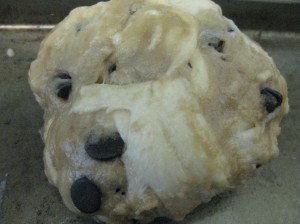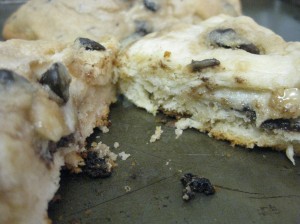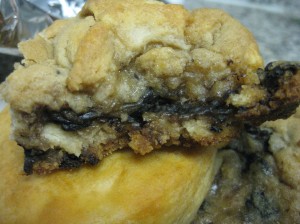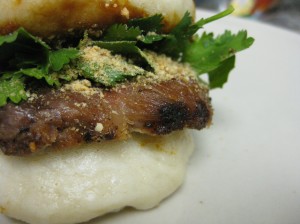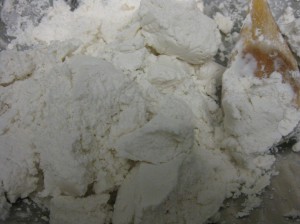Biscuit meets cookie
Scones. Buttery rich morsels of goodness with a delicate biscuit-like crumble and a light hint of sugar. Mmm, delicious. And also the inspiration for the experiment below.
One day I was sitting around thinking yet again about eating scones, when I began to ponder about its similarities to biscuits. To me, scones basically taste like a more rich, dense (and slightly drier) biscuit with sugar (and chocolate chips!). So then I figured…if I took biscuit dough…and mixed it with cookie dough (to give it the more dense consistency and sweeter flavor)…wouldn’t I get a scone? And better yet, they seem to bake at the same temperature for almost the same amount of time. Well, below is what happened…
First of all, I would like to note that I did not bother mixing the two doughs together with a mixer and instead opted to mix by hand. Not sure why, but that could’ve been a more conclusive experiment. Anyways, on to the results:
Half biscuit + Half cookie
For this test, I used equal parts of biscuit dough and cookie dough and mashed it together by hand.
Baked the dough at 375 degrees for 20 minutes (this took a LONG time to cook) and came out with…
Not bad, actually. Did not taste like a scone (by any stretch of the imagination), but it was interesting. It was like eating a biscuit, with layers of chewy cookie dough. Kind of like eating a Taiwanese dessert called Lao Po Bing, where a layer of mochi filling is wrapped around with a flaky, buttery pastry. But with much less defined layers. Onto the next one!
I also tried mixing 1/3 biscuit and 2/3 cookie dough and in the end, I’d say not to go that route. I won’t even post pictures. Next!
Finally, I tried a combo of 2/3 biscuit and 1/3 cookie dough.
This was by far my favorite. This cookie required the least amount of baking (about 12-13 minutes) and resulted in a nice balance of dry and gooey texture.
If I ever made these again, I would be sure to use the 2/3 biscuit and 1/3 cookie combo. And I’d probably try mixing with an actual mixer. And bake smaller pieces – these cookie biscuits are REALLY quite rich! But unfortunately, they did not turn into scones. Another day, I suppose!

